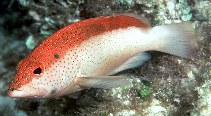| Family: |
Epinephelidae (Groupers) |
| Max. size: |
44 cm TL (male/unsexed); max. reported age: 11 years |
| Environment: |
reef-associated; marine; depth range 1 - 150 m, non-migratory |
| Distribution: |
Western Atlantic: South Carolina, USA and Bermuda to southern Brazil. |
| Diagnosis: |
Dorsal spines (total): 9-9; Dorsal soft rays (total): 14-16; Anal spines: 3-3; Anal soft rays: 9-9. Body and fins red; many small blue spots edged with black line scattered on body; dorsal edge of caudal peduncle with 2 prominent black spots; a pair of black blotches on tip of lower jaw (Ref. 13608); depth of body 2.6-2.9 in SL; head length 2.3-2.5 in SL; flat interorbital area; rounded preopercle, with shallow notch above the angle with upper edge finely serrate and moderately enlarged, lower edge fleshy; subopercle and interopercle smooth; posterior and anterior nostrils small and subequal; scaly maxilla, reaching to or beyond vertical at rear edge of eye; caudal fin convex posteriorly, corners angular; ctenoid lateral-body scales (Ref. 089707). |
| Biology: |
Adults prefer coral reefs and clear water. In the Gulf of Mexico, they are found in clear deep reefs (at least 45 m). At Bermuda and the West Indies, they are common in shallow water, but they usually hide in caves or under ledges during the day. The species is protogynous with females maturing at 16 cm TL and transforming to males at about 20 cm. Males are territorial. Feed mainly on small fishes and crustaceans. May follow morays and snake eels to feed on flushed preys. Wary, but approachable (Ref. 9710). |
| IUCN Red List Status: |
Least Concern (LC); Date assessed: 22 March 2018 Ref. (130435)
|
| Threat to humans: |
reports of ciguatera poisoning |
Source and more info: www.fishbase.org. For personal, classroom, and other internal use only. Not for publication.

